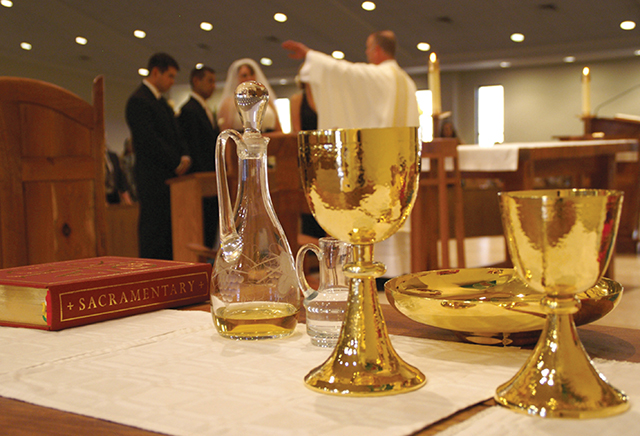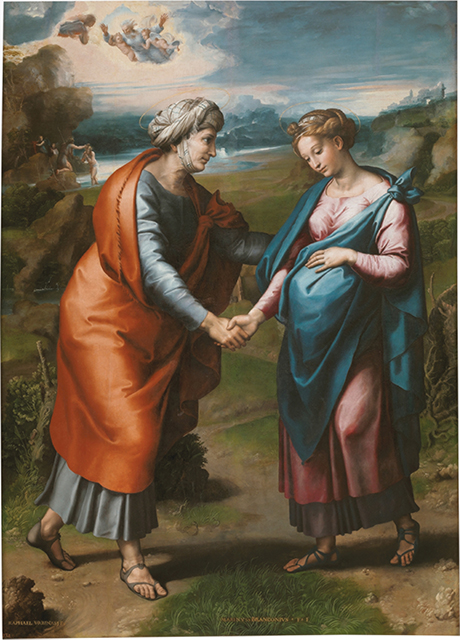Questions Catholics Ask

Feeding the hungry is a corporal work of mercy, but putting it into practice encompasses efforts at economic reform, too. (Photo: Congerdesign, Pixabay)
IF YOU TAKE your faith seriously, you probably have plenty of questions about it. In fact, a lifelong exploration of your questions will help you grow spiritually and intellectually. VISION brings you answers to a few important questions here. We encourage you to explore these questions and others in more depth in the VISION column, “Questions Catholics Ask” at VocationNetwork.org.
What are the corporal and spiritual works of mercy?
Listing the 14 works of mercy is easy; appreciating their breadth takes time. Let’s begin with the corporal works of mercy: feed the hungry, give drink to the thirsty, clothe the naked, visit the imprisoned, shelter the homeless, visit the sick, and bury the dead. Where do these come from? Six derive from the Last Judgment teaching in the Gospel of Matthew (25:34-40): “What you do for the least of these, you do for me.” The seventh work is grounded in traditional Hebrew respect for the body.
Feeding the hungry goes beyond soup kitchens to the level of economic reform. Satisfying thirst includes the politics of water rights and the ecology of preserving seas and rivers. Clothing the naked involves respecting the dignity of the poor as well as surrendering your cast-off attire. Visiting the imprisoned recognizes many kinds of captivity: domestic violence, sexism, racism, educational impoverishment. Sheltering the homeless includes welcoming the marginalized and lobbying for affordable housing. Visiting the sick expands to creating access for the disabled and inviting the infirm and elderly into the greater community. Burying the dead can include pardoning those who injured us long ago.
The spiritual works of mercy are next: admonish the sinner, instruct the ignorant, counsel the doubtful, comfort the sorrowful, bear wrongs patiently, forgive all injuries, and pray for the living and the dead. These teachings are gathered from the New Testament and 2 Maccabees 12:38-46 in Hebrew scripture. This eclectic list was compiled later than the first to balance the temporal (worldly) and spiritual obligations we owe each other. Saint Augustine of Hippo recorded both lists in 421; perhaps he was promoting what was already within Christian tradition.
While Jesus obliges all Christians to practice corporal works of mercy, some of the spiritual works require spiritual maturity to undertake them. We can all comfort the sad and must forgive trespasses and pray “unceasingly” for other’s needs, both living and deceased. Bearing wrongs patiently takes practice, but we can begin at once to form the habit. However, correcting sinners, teaching the ignorant, and counseling the hesitant are best left to those more advanced in Christian virtue and knowledge. Mercy has been called the meeting ground of love and justice. In works of mercy, compassion ascends to the level of service.

Why does the Catholic Church place so much importance on the sacraments?
There are plenty of ways to talk about the significance of sacraments. Among the most compelling is that they are actions that reveal and conceal God. This doesn’t imply that seven, and only seven, actions have this sacred power. Quite the opposite: the sacraments listed by the church (Baptism, Confirmation, Eucharist, Reconciliation, Anointing of the Sick, Matrimony, and Holy Orders) remind us how many ways God seeks to be known to us.
We find God at work in welcome and in mission and at meals. We experience God in hours of forgiveness and healing. We anticipate God in loving relationships and the call to service. As theologian Mark Francis says, what sacraments best reveal is the conviction that God’s loving intention is to save humanity—not to judge or condemn it. This intention isn’t just the basis for sacraments, but for the church’s very existence.
How did so many of us manage to miss this beautiful idea? Chances are we learned our lessons about sacraments without ever appreciating their meaning. The traditional definition of a sacrament that many of us were taught is that it’s an outward sign instituted by Christ to give grace. This formula, popularized at the Council of Trent (1545-63), was an outgrowth of an era that loved classifying things—especially since the Protestant Reformation was in the process of challenging every practice of the institutional church. Numbering the sacraments and explaining how they impart grace (by imprinting an indelible character or seal on the soul, for one) became the lesson plan. Reciting lists and formulas was emphasized over understanding what these symbolic actions communicate.
A sacrament is an event emerging from mystery. It bears a hidden component of divine love and power manifesting in space and time. Saint Augustine preferred to describe a sacrament rather than to define it. He called it a “visible word.” This fits more with contemporary theology, which names the Incarnation of Jesus (Jesus becoming human) as the first sacrament, and the church as the second one. If Jesus is the sacrament of God—revealing and concealing the “visible word”—and the church is the sacrament of Jesus, you and I might be rightly called sacraments of the church. We begin to understand why thoughtful participation in seven sacramental moments of church life is so significant. They train our vision to see where God is concealed, and seeks to be revealed, everywhere life takes us.
Where did the Hail Mary prayer come from?

No one knows who put together the series of Bible verses and intercession we know as the Hail Mary. There were several stages to the evolution of this prayer. The title “Mother of God” (Theotokos, or “God-bearer” in Greek) was used for Mary after church councils of the fourth and fifth centuries sanctioned it as theologically correct to describe her as more than “Christ-bearer” (Christotokos). Forms of this prayer existed in the sixth-century Eastern church. In the West, it was included in the Little Office of the Blessed Virgin Mary by the 11th century. The Hail Mary came into wider use in the 12th century, as the Crusaders invoked Mary to assist their quest to recapture the Holy Land.
The prayer is grounded in scripture with the angel’s greeting to Mary: “Hail Mary, full of grace, the Lord is with thee” (Luke 1:28). It continues with Elizabeth’s blessing for her young cousin during their visitation: “Blessed are thou among women, and blessed is the fruit of thy womb” (Luke 1:42). Elizabeth offers a standard Jewish birth-blessing praising the mother for the child she carries.
While we think of it as a Marian prayer, the Hail Mary is literally Christ-centered, as all Christian prayer should be. Many ancient writings held the key to their interpretation in the center. The hinge word of the Hail Mary is the name “Jesus.”
What follows is an invocation for Mary’s help (“pray for us”) as she is close to God, being both holy and divine mother. As the prayer begins with the angel’s identification of Mary as Spirit-filled (“full of grace”), then hinges on her relationship to Jesus, and finally ends with her relationship to God, in its entirety the Hail Mary reveals Mary as a willing participant in the work of the Trinity. The final line, “now and at the hour of our death,” was the last addition to the prayer, making it a particularly poignant entreaty for crusaders facing battle, the threat of plague, and other dangerous circumstances.
The Hail Mary also acknowledges Mary of Nazareth as a young girl whose faith in God is strong and true. This elevates Mary to the status of Abraham, whose faith made him father of nations. The Jewish community identifies itself as Abraham’s children. It’s fitting that Christians perceive themselves as children of Mary, our mother in faith.

What does it mean to be “saved”?
Salvation is one of those churchy words we use all the time with relatively little reflection. To Catholics of a certain generation, as well as some Christians, it simply implies you’re not going to wind up in hell for your sins. But that’s a very reductive idea. Being saved is so much more than that.
In theologian Jon Nilson’s wonderfully rich definition, salvation is the condition of the ultimate restoration and fulfillment of humanity and all creation effected by God’s action in Jesus Christ through the Holy Spirit. I mean, wow! This is so much bigger than the singular rescue of your soul or mine from eternal flames, so to speak. God’s desire to save includes everything. This reminds us of the words of Jesus after the multiplication of loaves: “Gather the fragments left over, so that nothing will be wasted.” It’s God’s plan that no crumb of creation is wasted.
The important question this raises is: Is this your plan and mine as well? Climate change reveals how human beings have been careless about the stewardship of life placed in our hands. Pope John Paul II’s admonitions concerning our “culture of death” point toward the many ways we “waste” life: in warfare, poverty, capital punishment, and abortion, among others. Pope Francis likewise warns about our “throwaway culture,” which pollutes the air, soil, and water in production, then tops off landfills as we discard these purchases for more. And we squander life in other ways: in the wasteful use of our time. In exploitative careers founded on personal greed rather than on meeting social needs. In addictive habits, injustice, racism, hate speech, attitudes of resentment, and so much more.
What seems clear is that, if we’re not saved—if we are, in fact, wasted or lost—it’s not because God wills it to be so. God’s design and desire are to rescue all. The story of salvation traced in scripture describes the perpetual efforts of a “saving God” who seeks to rescue and reconcile a people repeatedly and stubbornly choosing to wander into harm’s way. Heaven and hell, properly understood, are images that invite us to participate now in the happiness or misery we ultimately want. In Nilson’s words, “Taken seriously but not literally, [heaven and hell] are reminders of the ultimacy involved in one’s everyday decisions.” There should be no mystery in how we’ll spend eternity. Just contemplate how you spend today.
Excerpted from Questions Catholics Ask, vocationnetwork.org/blog/questions_catholics_ask.
Related article: VocationNetwork.org, “Ten great things about being Catholic.”
CORRECTION: An earlier version of this article incorrectly stated that the Hail Mary came into wider use in the 16th century. It should be the 12th century. We have updated this article on August 22, 2024.
Tags
Related
- What Catholics believe about the Eucharist
- How Jesus embraced his call
- Prayer: Our never-ending conversation with God
- What the church is teaching—and learning—about the sin of racism
- Church defined: Jesus calls; we respond
- A Creed to believe in
- On whose authority?
- Ten great things about being Catholic
- Following Jesus: Be ready for some surprises
- Enter into the divine Read More
Most Viewed
- Find your spirituality type quiz
- Questions and answers about religious vocations
- Celibacy quiz: Could I be a nun? Could I be a brother? Could I be a priest?
- Resources for older discerners or those with physical and developmental differences
- About Vocation Network and VISION Guide


